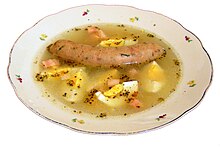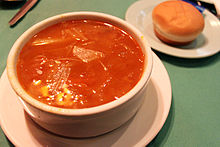
Ukrainian borscht with beans
As the home country of beetroot borscht,
Ukraine boasts great diversity of the soup's regional variants,
with virtually every district having its own recipe. Differences
between particular varieties may regard the type of stock used (meat,
bone, or both), the kind of meat (beef, pork, poultry, etc.), the choice
of vegetables and the method of cutting and cooking them. For example,
although the typical recipe calls for beef and pork, the
Kiev variant uses
mutton or lamb as well as beef, while in the
Poltava region, the stock for borscht is cooked on poultry meat, that is,
chicken,
duck or
goose. The use of zucchini, beans and apples is characteristic of the
Chernihiv borscht; in this variant, beetroots are sautéed in
vegetable oil rather than lard, and the sour taste comes solely from tomatoes and tart apples. The
Lviv borscht is based on bone stock and is served with chunks of
Vienna sausages.
Many regional recipes for borscht have also developed in
Russian cuisine. Examples include the
Moscow borscht, served with pieces of beef, ham and Vienna sausages;
Siberian borscht with
meatballs; and
Pskov borscht with dried
smelt from the local lakes. Other unique Russian variants include a monastic
Lenten borscht with marinated
kelp instead of cabbage and the
Russian Navy borscht (
flotsky borshch),
[f] the defining characteristic of which is that the vegetables are cut into square or diamond-shaped chunks rather than julienned.
Polish clear
Christmas Eve borscht served over
uszka, or ear-shaped mushroom-filled dumplings
As well as the thick borschts described above,
Polish cuisine offers a ruby-colored beetroot bouillon known as
barszcz czysty czerwony,
or clear red borscht. It is made by combining strained
meat-and-vegetable stock with wild mushroom broth and beet sour. In some
versions, smoked meat may be used for the stock and the tartness may be
obtained or enhanced by adding lemon juice, dill pickle brine, or dry
red wine. It may be served either in a soup bowl or – especially at
dinner parties – as a hot beverage in a twin-handled cup, with a
croquette or a filled pastry on the side. Unlike other types of borscht, it is not whitened with
sour cream.
Barszcz wigilijny, or
Christmas Eve borscht, is a variant of the clear borscht that is traditionally served during the Polish
Christmas Eve supper.
In this version, meat stock is either omitted or replaced with fish
broth, usually made by boiling the heads cut off from fish used in other
Christmas Eve dishes. The mushrooms used for cooking the mushroom broth
are reserved for
uszka (small filled dumplings), which are then served with the borscht.
Lithuanian cold borscht blended with sour cream or yogurt, and sprinkled with chives
In the summertime, cold borscht is a popular, refreshing alternative
to the aforementioned variants, which are normally served hot. It
consists of beet sour or beet juice blended with sour cream,
buttermilk,
soured milk,
kefir and/or
yogurt, and is refrigerated. The mixture has a distinctive pink or magenta color. It is typically served over finely chopped beetroot,
cucumbers,
radishes and
green onion, together with halves of a hard-boiled egg and sprinkled with fresh dill. Chopped
veal, ham, or
crawfish tails may be added as well. This soup probably originated in the
Grand Duchy of Lithuania,
which comprised the territories of modern-day Lithuania and Belarus,
and it is still part of the culinary traditions of these and neighboring
nations. The Lithuanian language is the only one in the region which
actually refers to it as 'cold borscht' (
šaltibarščiai). In Belarusian it is known simply as
khaladnik,
[g] or 'cold soup'; in Polish as
chłodnik litewski, or 'Lithuanian cold soup'; and in Russian as
svekolnik,
[h] or 'beetroot soup'.
Ashkenazi Jews living in Eastern Europe adopted beetroot borscht from their Slavic neighbors and adapted it to
their taste and religious requirements. As
combining meat with milk is proscribed by
kosher dietary laws, Jews have developed two variants of the soup: meat (
fleischik) and dairy (
milchik). The meat variant is typically made from beef brisket (pork is never used)
and cabbage, while the dairy one is vegetarian, blended with sour cream
or a mixture of milk and egg yolks. Both variants typically contain
beetroots and onions, and are flavored with beet sour, vinegar or citric
acid for tartness and
beet sugar for sweetness.
Galician Jews
traditionally liked their borscht particularly sweet. Jewish borscht
may be served either hot or cold, typically with a hot boiled potato on
the side. In prewar Eastern Europe it was traditionally put up to ferment around
Purim so that it would be ready four weeks later for the Passover holiday.
Without beets
Although in the English language
borscht refers almost
invariably to a beet-based soup, in some culinary cultures there exist
soups with the same or similar names where beetroots are absent or
merely optional. The principal common trait among them is a tart flavor
obtained by adding various sour-tasting ingredients.
Green borscht (
zeleny borshch),
[i] a light soup made from leaf vegetables, is an example common in Ukrainian and Russian cuisines. The naturally tart-tasting
sorrel is most commonly used, but
spinach,
chard,
nettle,
garden orache and occasionally
dandelion,
goutweed or
ramsons, may be added as well, especially after the spring season for sorrel has passed.
Like beetroot borscht, it is based on meat or vegetable broth and is
typically served with boiled potatoes and hard-boiled eggs, sprinkled
with dill. There is also a variety of Ukrainian green borscht which includes both sorrel and beetroots.
In Polish cuisine,
white borscht (
barszcz biały, also known as
żur or
żurek, 'sour soup')
[j] is made from a fermented mixture of
rye flour or
oatmeal
and water. It is typically flavored with garlic and marjoram, and
served over eggs and boiled fresh sausage; the water in which the
sausage was boiled is often used instead of meat stock. In the
Carpathian Mountains of southern Poland, variants of borscht are also made in which the tart taste comes from fermented milk products, such as
whey or buttermilk.
[42]
Although the deep red color of beetroot borscht may remind those
unfamiliar with Polish cuisine of blood, the kind of borscht that does
contain animal (usually poultry) blood mixed with vinegar is dark
brownish-gray in color and aptly called "gray borscht" (
barszcz szary), which is a regional name of the Polish blood soup better known as
czernina.
In
Romanian and
Moldovan cuisines, a mixture of
wheat bran or
cornmeal with water that has been left to ferment, similar to that used in Polish white borscht, is called
borș. It is used to impart a sour taste to a variety of tangy Romanian soups, known as either also
borș or
ciorbă. Variants include
ciorbă de perișoare (with meatballs),
ciorbă de burtă (with
tripe),
borş de peşte (with fish) and
borş de sfeclă roşie (with beetroots).
A bowl of luó sòng tāng, or Chinese borscht, made from cabbage and tomatoes
The
Armenian
version of borscht is a hot soup made with beef stock, green peppers
and other vegetables, which may or may not include beetroots, and
flavored with parsley and
cilantro. In
Chinese cuisine, a soup known as
luó sòng tāng,
[k]
or "Russian soup", is based on red cabbage and tomatoes, and lacks
beetroots altogether. Also known as "Chinese borscht", it originated in
Harbin, close to the Russian border in northeast China.
[49] In
ethnic Mennonite cuisine,
borscht
refers to a whole range of seasonal vegetable soups based on beef or
chicken stock – from spring borscht made with spinach, sorrel and chard
to summer borscht with cabbage, tomatoes,
corn and
squash to fall and winter borscht with cabbage, beets and potatoes.
Garnishes and sides
The
diversity of borscht styles is matched by the wide choice of garnishes
and side dishes with which various kinds of borscht may be served.
Borscht sprinkled with parsley, served with a dollop of sour cream and a slice of rye bread
Most often, borscht is dished up with sour cream, the East European version of which, known as
smetana, is runnier than its American counterpart.
The sour cream may be served in a separate pitcher for the diners to
add the desired amount themselves or the borscht may come already
"whitened",
[l] that is, blended with sour cream. Sometimes the cream is thickened with flour before being added to the soup. Yogurt and a mixture of milk and
yolks are possible substitutes.
Chopped herbs are often sprinkled on the surface of the soup; dill is most common, but parsley,
chives or
scallion are often added as well. Individual helpings may be spiced up with minced hot peppe








0 Comment to "love"
Post a Comment